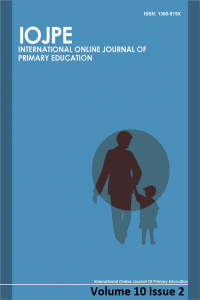Abstract
Factors and multiples are important aspects of mathematical structure that support the understanding of a range of other ideas including multiplication and division, and later on, factorization. At primary school level, it is important that factors and multiples are taught as a connected enterprise and as vital parts of the multiplicative situation; that is multiplication and division. The primary objective of the study on which this paper is based was to determine the extent of children’s understanding of factors and multiples. A written quiz containing questions about factors and multiples and asking for children to explain their responses, was administered. Results suggest that the language involved with factors and multiples may play a role in the extent to which children develop a conceptual understanding of them. Also, most children know some things about factors and multiples but struggled to connect and articulate ideas when factors and multiples were presented in a different context. In conclusion, the inconsistency of participant responses suggests that teaching about factors and multiples needs to emanate from a more conceptual and connected standpoint.
Keywords
References
- Bana, J., Marshall, L., & Swan, P. (2014). Maths handbook for teachers and parents. Greenwood, Western Australia: R.I.C. Publications.
- Check, J., & Schutt, R. K. (2012). Survey research. In J. Check, R. & K. Schutt (Eds.), Research methods in education. Sage.
- Cresswell, J. W., & Cresswell, J. D. (2018). Research design: Qualitative, quantitative and mixed methods approaches. (5th Ed.) Sage.
- Creswell, J. W., & Plano Clark, V. L. (2011). Designing and conducting mixed methods research. 2nd Edition, Sage.
- Day, L., & Hurrell, D. (2015). An explanation for the use of arrays to promote the understanding of mental strategies for multiplication. Australian Primary Mathematics Classroom, 20(1), 20-23.
- Denzin, N. (2004). Symbolic Interactionism. In U. Flick, E. Kardorff, & I. Steinke (Eds.). A companion to qualitative research (pp. 81 - 86). Sage.
- Downton, A., & Sullivan, P. (2017). Posing complex problems requiring multiplicative thinking prompts students to use sophisticated strategies and build mathematical connections. Educational Studies in Mathematics, 95(3), 303–328. https://doi.org/10.1007/s10649-017-9751-x
- Drake, M. (2012). On the trail of multiplicative thinking. Mathematics Teaching, 228, 45-49.
- Feldman, Z. (2014). Rethinking factors. Mathematics Teaching in the Middle School, 20(4), 231-236. https://doi.org/10.5951/mathteacmiddscho.20.4.0230
- Griffiths, M. (2017) Exploring perfect numbers. Mathematics Teaching, 259, 36-38.
- Güneş, C. (2021). A quantitative shift towards multiplicative thinking. Digital Experiences in Mathematics Education, 7(3), 361–394. https://doi.org/10.1007/s40751-021-00094-8
- Hurst, C. (2015). The multiplicative situation. Australian Primary Mathematics Classroom, 20(3), 10–16.
- Karp, K. S., Bush, S. B., & Dougherty, B. J. (2015). 12 math rules that expire in the middle grades. Mathematics Teaching in the Middle School, 21(4), 208-215.
- Kaushik, V., & Walsh, C. A. (2019). Pragmatism as a research paradigm and its implications for social work research. Social sciences, 8(9), 255. https://doi.org/10.3390/socsci8090255
- Lemonidis, C. (2016). Mental computation and estimation: Implications for mathematics education research, teaching, and learning. London: Routledge.
- Mathematics Assessment Resource Service (MARS). (2015). Finding factors and multiples. Nottingham: Shell Centre, University of Nottingham. Retrieved from: https://www.map.mathshell.org/lessons.php?unit=6110&collection=8
- McEachran, A. (2008). Learning about primes. Mathematics Teaching, 207, 23-25.
- McKenna, S. (2019). Discussion, conjectures, noticing. Mathematics Teaching, 267, 38-39.
- National Council for Teachers of Mathematics – NCTM. (2013). Demystifying multiplication. Retrieved from: https://www.nctm.org/Publications/Student-Explorations-in-Mathematics/2013/Demystifying-Multiplication-_November-2013_/
- Ollerton, M., & Cooper, K. (2017). Learning to teach and teaching to learn. Mathematics Teaching, 255, 12-16.
- Parker, G. (2019). Teaching multiplication tables. Mathematics Teaching, 265, 11-13.
- Richards, A. (2014). Working towards a ‘child-friendly’ written progression for division. Mathematics Teaching, 240, 15-18.
- Richards, M. (2007). Releasing the prisoners. Mathematics Teaching, 203, 38-39.
- Rickard, C., & Earle, L. (2019). Learning times-tables facts versus learning about times tables. Mathematics Teaching, 265, 14-17.
- Siemon, D., Warren, E., Beswick, K., Faragher, R., Miller, J., Horne, M., Jazby, D., Breed, M., Clark, J., & Brady, K. (2021). Teaching mathematics: Foundations to middle years (3rd ed.). Docklands, Victoria: Oxford.
- Teddlie, C., & Tashakkori, A. (2009). Foundations of mixed methods research: Integrating quantitative and qualitative Approaches in the social and behavioural sciences. Sage.
- Thompson, I. (2012). To chunk or not to chunk. Mathematics Teaching, 227, 45-48.
- Turton, A. (2007). The Origo handbook of mathematics education. Brisbane: Origo.
Details
| Primary Language | English |
|---|---|
| Subjects | Other Fields of Education |
| Journal Section | Research Articles |
| Authors | |
| Publication Date | December 31, 2021 |
| Published in Issue | Year 2021 Volume: 10 Issue: 2 |
Creative Commons Licenses

All articles published in International Online Journal of Primary Education's content is licensed under a Creative Commons Attribution 4.0 International License (CC BY 4.0).
(Counter start: February 28, 2021)





